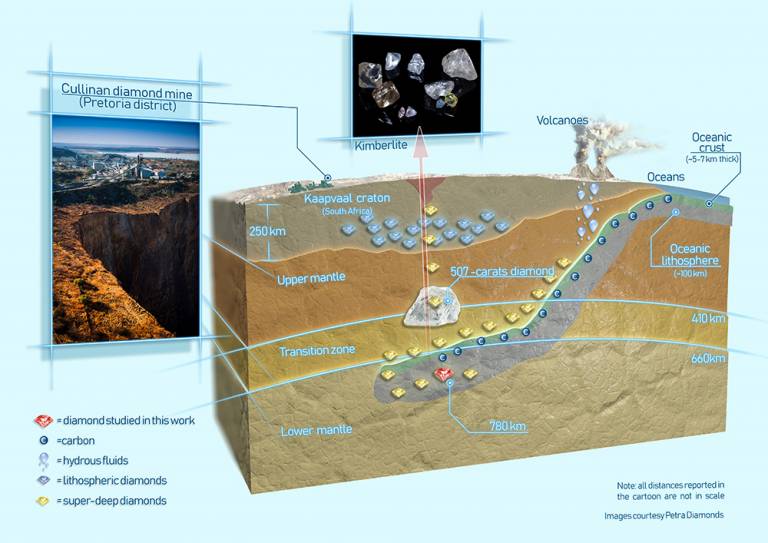Deep into the Earth: diamonds and surficial carbon down to 800 km depth in the Earth’s lower mantle
8 March 2018
First evidence in nature of Earth's fourth most abundant mineral, calcium silicate perovskite is reported in Nature paper.

A team of geologists from Italy (University of Padova, University of Pavia and CNR-IGG Padova), Canada (University of British Columbia and University of Alberta), UK (University College London), and South Africa (University of Cape Town and Rhodes University) definitively proved what geophysicists indirectly predicted so far, i.e. the oceanic crust and surficial carbon can reach the lower mantle (below 660 km depth) by subduction processes.
The discovery, published in Nature was possible thanks to the study of a special “super-deep” diamond from the famous Cullinan mine (South Africa), where the world’s largest 3107-carats Cullinan diamond was found more than 140 years ago. In detail, the research team, including Dr Martha Pamato from the Department of Earth Sciences at UCL, discovered, the first natural CaSiO3 mineral with a perovskite crystal structure still trapped within the diamond. Many deep Earth scientists had predicted that this mineral would never be found at the Earth’s surface, even though there are zetta tonnes (1021 tonnes) of this material buried deep in the Earth. This very high-pressure form of calcium silicate (CaSiO3) can be stable only from about 600 km depth in Earth’s mantle, continuing to be stable right through the lower mantle. This specific inclusion within diamond shows a chemical composition which would indicate that the diamond formed at about 780 km depth in the Earth’s lower mantle and, at the same time, that the inclusion is derived from oceanic crust (see the cartoon). The research team analysed the carbon forming the diamond, and this indicates its surficial derivation. The discovery is the first definitive prove of oceanic crust and surficial carbon recycled by subduction into Earth’s lower mantle as predicted by seismic images and geodynamic modelling.
Fortunately, only diamond, thanks to its unique strength, can survive such a long and complex journey from the deepest regions of our Planet into our hands in the lab, definitively opening “windows” to the deep Earth. The CaSiO3-perovskite inclusion, based on laboratory experiments, would represent the fourth most abundant mineral in the Earth and main carrier of radioactive elements (like U and Th) in the lower mantle, contributing to the heat production that drives mantle convection and plate tectonics.
Related Links:
- CaSiO3 perovskite in diamond indicates the recycling of oceanic crust into the lower mantle. F. Nestola, N. Korolev, M. Kopylova, N. Rotiroti, D. G. Pearson, M. G. Pamato, M. Alvaro, L. Peruzzo, J. J. Gurney, A. E. Moore & J. Davidson. Nature 555, 237-241. doi:10.1038/nature25972
- Dr Martha Pamato Research Profile
- Diving 780km to discover where diamonds are formed.University of Padova
- Never-Before-Seen Mineral Found Inside a 'Super Deep' Diamond. National Geographic
- Rare Deep Diamond With Perovskite Shows Ocean Crust Recycles Into Earth’s Mantle.
 Close
Close

